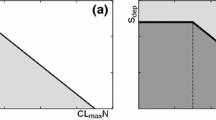Numerous assumptions have been made over the past 17 years when calculating critical loads for soils, both for acidity (based upon base cation steady state mass balances (SMB)) and for N (eutrophication, based upon N mass balances), often without all the assumptions being explicitly stated. The tacit assumptions that the author believes to be implicit in the SMB approach are critically reviewed, with particular reference to upland regions where slope processes are highly significant. It is concluded that many of them cannot be justified, especially those that involve ignoring many key processes known to be important to biogeochemical cycling and soil evolution in upland catchments. The evidence presented suggests that critical loads of acidity and of N for soils should be based upon effective pollutant and, for acidity, also effective base cation deposition concentrations, rather than upon pollutant deposition fluxes. This is because of the dominant role of cation exchange equilibria, rather than weathering rate, in regulation of the pH and base status of the more acidification-sensitive soils, and because of the importance of transport down slope of base cations, alkalinity and N species.
Access this chapter
Tax calculation will be finalised at checkout
Purchases are for personal use only
Preview
Unable to display preview. Download preview PDF.
Similar content being viewed by others
References
Cresser, M. S. (2000). The critical loads concept: Milestone or millstone for the new millennium? Science of the Total Environment, 249, 51-62.
Cresser, M. S., Smart, R., Billett, M. F., Soulsby, C., Neal, C., Wade, A., et al. (2000). Modelling water quality for a major Scottish river from catchment attributes. Journal of Applied Ecology, 37(Supplement 1), 171-184.
Edwards, A. C., Creasey, J., Skiba, U., Peirson-Smith, T., & Cresser, M. S. (1985). Long-term rates of acidification in UK upland acidic soils. Soil Use and Management, 1, 61-65.
Hornung, M., Bull, K., Cresser, M., Hall, J., Langan, S., Loveland, P., et al. (1995). An empirical map of critical loads for soils in Great Britain. Environmental Pollution, 90,301-310.
ICP (2004). Modelling and Mapping Manual, available on the web at: http://www.icpmapping.org/html/manual.html, accessed October 2005.
Langan, S. J., Hall, J., Reynolds, B., Broadmeadow, M., Hornung, M., & Cresser, M. S. (2004). The development of an approach to assess critical loads of acidity for woodland habitats in Great Britain. Hydrology and Earth System Sciences, 8, 355-365.
Nilsson, J., & Grennfelt, P. (Eds.) (1988). Critical loads for sulphur and nitrogen: Report 15. Copenhagen: Nordic Council of Ministers.
Skiba, U., & Cresser, M. (1989). Prediction of long-term effects of rainwater acidity on peat and associated drainage water chemistry. Water Research, 23, 1477-1482.
Smart, R. P., Cresser, M. S., Calver, L. J., Clark, M., & Chapman, P. J. (2005). A novel modelling approach for spatial and temporal variations in nitrate concentrations in an N-impacted UK upland river network. Environmental Pollution, 136, 63-70.
Smart, R. P., Soulsby, C., Cresser, M. S., Wade, A. J., Townend, J., Billett, M. F., et al. (2001). Riparian zone influence on stream water chemistry at different spatial scales: A GIS-based modelling approach, and example for the Dee, NE Scotland. Science of the Total Environment, 280,173-193.
Stutter, M., Langan, S., & Cresser, M. S. (2003). Weathering and atmospheric deposition signatures of base cations in upland soils of NE Scotland: Their application to critical load assessment. Geoderma, 116, 301-324.
Stutter, M., Smart, R., & Cresser, M. S. (2002). Calibration of the sodium base cation dominance index of weathering for the River Dee Catchment in north-east Scotland. Applied Geochemistry, 17, 11-19.
Sverdrup, H., de Vries, W., & Henriksen, A. (1990). Mapping critical loads: A guidance to the criteria, calculations, data collection and mapping of critical loads; Report Nordic 1990-1998. Copenhagen: Nordic Council of Ministers.
White, C. C., Cresser, M. S., & Langan, S. J. (1996). The importance of marine derived base cations and sulphur in estimating critical loads in Scotland. Science of the Total Environment, 177, 225-236.
White, C., Dawod, A., Cruickshank, K., Gammack, S., & Cresser, M. (1995). Evidence for acidification of sensitive Scottish soils by atmospheric deposition. Water, Air and Soil Pollution, 85, 1203-1208.
Author information
Authors and Affiliations
Editor information
Editors and Affiliations
Rights and permissions
Copyright information
© 2007 Springer Science + Business Media B.V
About this chapter
Cite this chapter
Cresser, M.S. (2007). Why Critical Loads of Acidity and N for Soils Should be Based on Pollutant Effective Concentrations Rather Than Deposition Fluxes. In: Brimblecombe, P., Hara, H., Houle, D., Novak, M. (eds) Acid Rain - Deposition to Recovery. Springer, Dordrecht. https://doi.org/10.1007/978-1-4020-5885-1_46
Download citation
DOI: https://doi.org/10.1007/978-1-4020-5885-1_46
Publisher Name: Springer, Dordrecht
Print ISBN: 978-1-4020-5884-4
Online ISBN: 978-1-4020-5885-1
eBook Packages: Earth and Environmental ScienceEarth and Environmental Science (R0)



